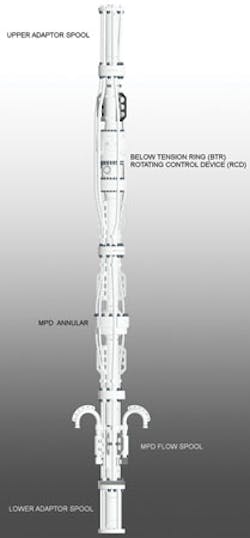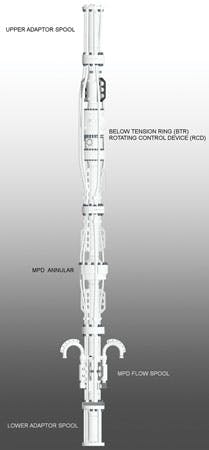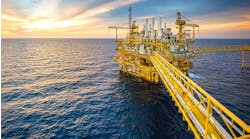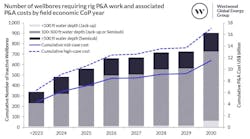Approach restores production to deepwater presalt well
Leonel Carreño, Angel Hernandez
Weatherford International
Deepwater presalt plays present significant challenges to well construction that conventional drilling techniques are unable to resolve promptly or profitably. An operatoroffshore Brazil was reminded of this fact when attempting to reenter and explore the production potential of a P&A’d well.
The deepwater exploratory oil well was considered undrillable using conventional overbalanced drilling practices because of bottomhole pressure challenges. The presalt, carbonate formation was naturally fractured and prone to drilling fluid losses of up to 60 bbl/hr (9.5 cu m/hr) in areas where high-pressure and loss zones were encountered.
The operator ran cement plugs to isolate the wellbore and reduce the frequency of lost circulation events. But even after pumping 10 plugs, the fluid losses continued, preventing the well from reaching total depth (TD) and prompting the operator to abandon its initial drilling program.
When the operator decided to try a different approach,Weatherford was selected as the service provider – in large part because of the company’s track record of deploying managed pressure drilling (MPD) services to drill more than 25 challenging wells in Brazil. An adaptive drilling technique that precisely controls a wellbore’s annular pressure profile, MPD deploys automated control systems that detect minute downhole pressure changes and then quickly adjust surface backpressure to minimize the magnitude of kicks or fluid losses. MPD brings added safety and efficiency to a drilling operation, helping to ensure that the driller reaches total depth at lower costs and less risk.
Dynamic pore-pressure and formation-integrity tests determined the well’s drilling window to be 0.89 lb/gal (106.64 kg/cu m). Given this narrow window, the team devised a comprehensive MPD strategy that would maintain constant bottomhole pressure to minimize losses and influxes while delivering the well to total depth.
An integrated MPD solution
An MPD riser joint was built containing a Weatherford below-tension ring rotating control device (RCD). This RCD, a pressure-control solution for annulus gas diversion during drilling, is integrated into the riser to create a positive seal around the rotating drill pipe and tool joints. This has the effect of constantly isolating the annulus and diverting annulus returns for enhanced safety and minimal environmental risk.
The RCD was coupled with Weatherford’s Microflux control system, which identifies minute fluid influxes and losses early and with a high degree of precision. The control system can identify unique properties of different wellbore events, and subsequently distinguish between a potentially hazardous kick and a relatively harmless event such as wellbore ballooning and breathing.
The Weatherford MPD riser joint contains an MPD flow spool, an annular isolation device, and a below-tension-ring RCD, all of which work to enable closed-loop drilling in deepwater environments. (Image courtesy Weatherford)
In addition to the RCD, the control system incorporates a Coriolis mass flowmeter that captures data on mass and volume flow, as well as mud weight and temperature, from returning annulus fluids at a sample rate of multiple times per second. These data are then routed to an independent SCADA control system that houses several data acquisition components for measuring and analyzing fluid properties into one system. This intelligent control system uses proprietary algorithms to detect downhole kicks and losses and categorize their relative threat level to the integrity of the well.
These datasets are transmitted in real time to a newly built MPD decision support center in Rio de Janeiro. The state-of-the-art facility contains an operations room for support personnel, a conference room with video/teleconferencing capabilities, and a control room that houses multiple monitoring stations and simultaneously displays streaming MPD data on up to 24 individual drilling rigs. Through constant monitoring of the drilling operation, the center allows service company engineers and drilling advisors to collaborate with their counterparts from the operator’s organization to investigate and properly diagnose wellbore events, tailor the appropriate response to an event, and keep drilling to total depth with minimal expenditures.
Reaching the target
Drilling proceeded with this comprehensive solution. Each time a loss zone was detected, the team used the control system to adjust the wellbore pressure profile by applying surface backpressure. Even with a reduction in mud weight returns of 0.08 lb/gal (9.59 kg/cu m), the system maintained constant bottomhole pressure and enabled drilling to continue for the remainder of the section.
The well was landed to a TD of approximately 21,325 ft (6,500 m), providing access to a 1,043-ft (318-m) reservoir containing API 31° oil. By promptly detecting losses and adjusting bottomhole pressure, the MPD system helped the operator avoid nonproductive time (NPT) while transforming an abandoned well into a productive asset.
Expanding MPD’s reach
MPD’s success at delivering this well has been replicated many times in other narrow-window formations in the region. This has saved the operator millions of dollars on well construction costs compared to conventional overbalanced drilling programs. The operator has also begun expanding the application of MPD to drill into depleted reservoirs with low pore pressures using a variation known as pressurized mud cap drilling (PMCD). PMCD involves drilling with no returns to surface and with an annulus fluid column, assisted by surface pressure, maintained above the formation. This fluid column, or mud cap, is kept underbalanced against the lowest reservoir pressure to encourage production and prevent lost circulation events.
Since rolling out its integrated deepwater MPD service, Weatherford has helped the operator retrofit more than a dozen drilling rigs for MPD operations in the so-called Golden Triangle region of Brazil, West Africa, and the US Gulf of Mexico. The operator and service provider continue to partner on these retrofit installations for drillships working in Brazil, with the aim to make every drillship working in Brazilian waters fully MPD capable.
Success in Brazil is spurring developments in other parts of Latin America that have not traditionally used MPD in their field developments. The service provider is currently preparing an MPD operation in a first-of-its kind application in the deepwaters of the Caribbean Sea, off the coast of Colombia.
In preparation for this large drilling program, the company is drawing on the experience and knowledge gained from its Brazil operations. The drilling rig is currently being retrofitted in Africa, and Weatherford MPD specialists from Brazil and other regions are on location, rigging up the MPD equipment and ensuring that it performs seamlessly with the other systems on the rig. When the rig arrives to begin drilling in late 2016, MPD specialists from Brazil will be part of the rig crew to ensure that the operator gets the maximum benefit from the system, and lands the well to total depth safely and cost effectively.
With each new application, Weatherford’s integrated MPD service is proving to be a safe and efficient means of making undrillable wells drillable. And by reducing NPT and getting wells to total depth faster, the service optimizes the profitability of expensive offshore wells – a major benefit whether oil prices are high or low.




